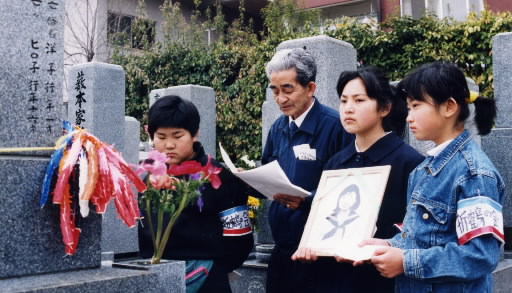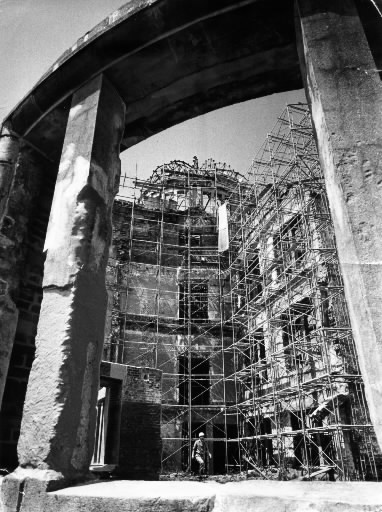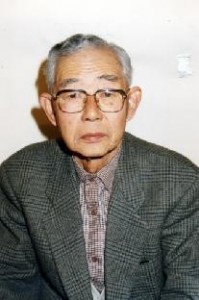History of Hiroshima: 1945-1995 (Part 16, Article 2)
Mar. 6, 2013
Atomic Bomb Dome
by Masuhei Ono, Senior Staff Writer
Note: This article was originally published in 1995.
Seeking to turn the devastating reality of the atomic bombing into a lasting memory of the human race, the A-bombed city of Hiroshima has made efforts to preserve and maintain A-bombed ruins, gather and archive bombing-related testimonies, records, and documents, and investigate the facts of the A-bomb damage. The city is now involved in a campaign to “reconstruct” the hypocenter, creating a map which attempts to “restore” a part of town that vanished in the blast and thereby shed light on the lives, deaths, and A-bomb experiences of those who once lived in this area. Along with this effort, preservation work on the Atomic Bomb Dome, which is building momentum for gaining a “World Heritage site” designation for the structure, is the embodiment of action undertaken by the city as a whole. Like many other efforts, the private sector has taken the lead over the public sector, and the progress made in these campaigns has largely been attributed to the work of private citizens. With regard to the campaign to “reconstruct” the hypocenter, the inspiration of a young director at the Hiroshima branch of Japan’s national broadcaster, NHK, and his station’s passion for the idea, played a large role in advancing the effort prior to the involvement of the City of Hiroshima and the Research Institute for Nuclear Medicine and Biology at Hiroshima University. Behind the preservation of the Atomic Bomb Dome was the “Hiroshima Paper Crane Club” and a tenacious man who served as the group’s leader for nearly 40 years. The Chugoku Shimbun now turns its attention to these Hiroshima campaigns which exemplify the preservation efforts of the city.
Ichiro Kawamoto of the Hiroshima Paper Crane Club: Behind the scenes, a key player who forges his own path
An inconspicuous presence can be seen when flipping through a high stack of news photographs which convey the nearly 40-year history of activities undertaken by the Hiroshima Paper Crane Club: a short man with thick eyebrows, appearing to radiate a strong will, is found along the perimeters of many of the photos.
The man is Ichiro Kawamoto, a resident of downtown Hiroshima. Since the founding of the group in 1958, Mr. Kawamoto has joined hands with more than 200 children and, in his role behind the scenes, has devoted much of his life to preserving the Atomic Bomb Dome, visiting and comforting A-bomb survivors, and welcoming international visitors to the city. Mr. Kawamoto turns 66 this year, and the Chugoku Shimbun traces his life to date.
On August 28, 1960, six years before the City of Hiroshima began its own fundraising campaign to preserve the Atomic Bomb Dome, about ten children were seen appealing for the preservation of the A-bombed building, calling for donations and signatures in front of the Children’s Peace Monument in Hiroshima Peace Memorial Park.
Touched by the diary of Hiroko Kajiyama, then 16, a girl from Hiroshima Prefecture who had died of leukemia in April of that year, Mr. Kawamoto launched the effort along with members of the Hiroshima Paper Crane Club. Previously, there had been discussions over whether to preserve or demolish the dome, but this was the first concrete action undertaken with the intention of preserving it.
The students who gathered at the site--elementary, junior high, and high school students with sweat on their brows--raised a sign that said “Let’s protect the Atomic Bomb Dome” and handed out mimeographed leaflets. The leaflets appealed for the preservation of the dome and included words from Hiroko’s diary that were written on August 6, 1959: “After the 20th century has passed, the inscription on the Cenotaph for the A-bomb Victims and the Atomic Bomb Dome, as a painful reminder of the past, can convey the horror of the atomic bombing to the world long into the future.”
At the time, it could not be said that the wider public viewed the presence of the Atomic Bomb Dome in a favorable light. The Chugoku Shimbun’s evening edition of October 10, 1948 argued that the dome be cleared away, saying: “It is time for the citizens of Hiroshima to end the dismal mindset of showing off the pockmarked face of the city to the world in an attempt to draw sympathy.” The mayor of the city and the governor of Hiroshima Prefecture, among others, supported this position as well.
In an article in the Chugoku Shimbun, dated February 15, 1953, Hiroshima Mayor Shinso Hamai stated: “I hope to gather everything that casts a shadow of the atomic bombing and store these things in Peace Memorial Museum so the citizens of Hiroshima will not have to look upon them.” Known as the “A-bomb mayor,” Mr. Hamai nearly died in the flames of the atomic bombing in his effort to rescue others. He probably wanted to remove the wreckage of the blast as swiftly as possible, in order to erase such reminders of the nightmare, and revive the A-bombed city of Hiroshima to stand as a beautiful city of peace.
Mr. Kawamoto, however, has been navigating the hardships of war and immigration, stormy waves whipped up by a monster of a nation, since the time he was a child. Consequently, he found it hard to believe that peace could be achieved simply by praying and displaying artifacts of the atomic bombing. To him, peace was like a “precious jewel” that could only be gained through tireless practice and action.
Mr. Kawamoto was born in Lima, Peru in January 1929, the child of emigrants from Hiroshima. He lost his father when he was just two, then came to Japan with his mother on a spring day at the age of 13. It was the first time he saw the homeland and hometown of his parents, but the greeting was cold. Someone told them: “You took the liberty of leaving here, but you’ve come back because you weren’t able to make a living there...”
Mother and son drifted on to Osaka. Destitute, and unable to seek proper medical care, his mother died of illness. The orphaned boy returned to Hiroshima, but could find no relatives offering a warm welcome.
Then the atomic bomb fell. Though Mr. Kawamoto managed to escape a direct exposure to the bomb, he entered the city the next day to help with the rescue efforts. He saw the devastated city and smelled the hellish stench. After the war, he wanted to return to Peru, the land of his birth, so he began learning English at the YMCA. He also helped at a Sunday school, and came to make friends with A-bomb orphans and other war orphans.
These orphans called Mr. Kawamoto, a returnee from South America, “Big Brother of the Andes” and they formed a close bond. These were the first ties between Mr. Kawamoto and children. Afterwards, Mr. Kawamoto was an active force, alongside such associates as American missionary Mary McMillan and A-bomb survivor Kiyoshi Kikkawa, in efforts to provide relief to A-bomb survivors and promote peace. Then he plunged into a unique peace campaign by joining hands with children.
Mr. Kawamoto paid visits to poor A-bomb survivors, mainly those at the Hiroshima Atomic Bomb Hospital, and offered them comfort. He communicated with people overseas who were interested in the A-bombed city of Hiroshima. These efforts, which he made unattached to any group or organization, have been pursued from a child’s perspective.
Over time, the children’s nickname for Mr. Kawamoto changed from “Big Brother of the Andes” to “Big Brother Kawamoto” to “Uncle Kawamoto.” And the children themselves came and went, one after another. Mr. Kawamoto, though, has never changed.
“I have a lot of free time, relatively speaking.” This is the reason he has spent most of his life since the war working as a janitor at Hiroshima Jogakuin School. He has not felt any desire to win distinction in social circles. The activities of his club have come before everything else.
The effort to preserve the Atomic Bomb Dome was the first campaign that the Hiroshima Paper Crane Club pursued in earnest. Even after several years of continuous action, however, they could see no discernible reaction. One A-bomb survivor hissed in front of a donation box: “I’d like you to save us, not that thing.”
“No matter how hard we tried, there was no positive response,” Mr. Kawamoto said, reflecting on that time. “I was struck by the cold futility of it all, and I felt like giving up a number of times. But the encouragement I received from Hiroko’s mother, and a visit to the girl’s grave, helped keep me going.”
It was not until the end of 1964 that their persistent efforts began to gradually bear fruit. The Japan Congress Against A- and H-bombs, A-bomb survivors, and citizens’ groups, among others, began to respond to the humble appeal of the Hiroshima Paper Crane Club. Support also began to stir within the Hiroshima City Council.
On the evening of July 11, 1966, in the club’s small office located in the Minami Danbara area, so many members of the club had gathered that some were unable to find a place to sit. They had heard that the Hiroshima City Council would decide the fate of a resolution to preserve the Atomic Bomb Dome.
“At around 7 p.m., two journalists rushed into the room and told us that the resolution to preserve the dome was passed,” recalled Eiko Mikami, 49, a resident of Minami Ward and an ardent member of the club back then. “I was so happy. We were all in tears, rejoicing over the news.” It had been six years since the club first launched its petition and fundraising drive.
The Hiroshima Paper Crane Club is an unusual group. To date, more than 200 children have been members, though few of them remain in the group and stay active in its efforts after graduating from junior high or high school. Because of this turnover, criticism has been leveled against Mr. Kawamoto, with such comments as: “In the end, he’s just using the children. It’s not educational--he treats the children like pawns.”
Ms. Mikami, however, disagrees. “I learned about helping others,” she said. “I’m glad I was part of the group.” Even after graduating from high school, she would often visit the group when she was free.
Eiichi Hashimoto 69, former principal of Hiroshima Jogakuin Senior High School and president of the Christian Network for Peace in Hiroshima, said about Mr. Kawamoto: “He has a strong personality and he’s independent-minded about his activities. He instinctively dislikes being part of an organization and instead devotes himself fully to individual efforts. For these reasons, he’s often misunderstood. But the life he has led, with the A-bombed city of Hiroshima serving as his backbone, demonstrates the furious will to live and the startling power of one’s actions.
To commemorate the completion of the effort to preserve the Atomic Bomb Dome, the City of Hiroshima produced a booklet entitled “Memorial Report on the Preservation of the Atomic Bomb Dome: The Dome Appeals to Us.” In this booklet is found, among other things, information on the process by which the dome came to be preserved. However, the 88-page booklet contains just one sentence about the Hiroshima Paper Crane Club: “The Hiroshima Paper Crane Club raised money, too.”
Mr. Kawamoto has little to say about such criticism or comments. “I don’t expect a lot of children,” he said. “I only hope that they will do what they can and develop common sense as people of the A-bombed city of Hiroshima. I have never burdened the children with these activities.” He added that he has neither tried to retrieve children who decided to leave the group nor rejected children who wished to join. Mr. Kawamoto has remained unruffled by the reactions of local government officials and other peace groups or organizations: “I only graduated from elementary school, so I guess I can’t expect much more from them.”
After retiring from Hiroshima Jogakuin School last year, Mr. Kawamoto has been living off his retirement allowance. He then signed up to take part in the city’s human resources center for senior citizens, thinking, “If there’s any job I can do, I’ll do it.” He said he would like to work as a volunteer until the day he dies.
On the Sunday that fell before April 5, the anniversary of Hiroko’s death, Mr. Kawamoto offered flowers and paper cranes to Hiroko’s grave at Senkoji Temple in Higashi Ward, Hiroshima, something he has done with children from the Hiroshima Paper Crane Club every year.
Mr. Kawamoto first spoke to Hiroko, telling her that chances were good the Atomic Bomb Dome would be designated a World Heritage site, and then made a silent prayer. The sunshine breaking through the clouds at odd moments made the colors of the red and yellow cranes glow. The hair of the solitary peace activist, who has held fast to his high aspirations in a role behind the scenes of the A-bombed city, has turned completely gray.
Shigeo Sato, working to preserve the dome, uses epoxy for reinforcement
“At first, I was worried about how the Atomic Bomb Dome could be preserved,” said Shigeo Sato, 82, looking back on those days. Professor Sato, a resident of Hatsukaichi City and a professor emeritus at Hiroshima University, served as the leader of two preservation projects at the request of the City of Hiroshima.
Restoring the building to its former state, and preserving it in that condition, would not have been so difficult a task. However, preserving it in its damaged state, having been destroyed by the atomic bomb and now no longer being used as a building, was not anywhere near as simple as people had suggested.
A survey found that the total length of visible hairline cracks came to three kilometers, while other cracks--more like clefts--amounted to over one kilometer. In addition, the bricks were simply laid and reinforcing bars were included in only part of the brick work. “When I learned that it was possible to use epoxy resin to firmly fix the walls, I jumped for joy,” Professor Sato said.
Before the war, Professor Sato worked as an architect and he was employed by the Western General Communications Office of the national institute of communications, located in Hiroshima’s Hakushima district. On the day of the bombing, August 6, he was in Tokyo on a business trip, and so escaped the blast, but he lost many colleagues and acquaintances. In 1949, four years after the bombing, he made a submission for the design competition for Hiroshima Peace Memorial Park, partly as a way to console the souls of the dead, but Kenzo Tange, a younger professor at the University of Tokyo, took first prize. Professor Sato had to conceal his heartache.
Because of this past, Professor Sato was all the more devoted to the preservation projects involving the Atomic Bomb Dome. He faced criticism for his decisions, with comments like “It would be a mistake to combine inorganic matter, like bricks, with epoxy resin, an organic matter made from oil” and “Epoxy resin is too expensive.” He endured the criticism, thinking, “I’ll provide answers to these concerns once I have the results.”
Professor Sato described the durability of the dome, which has undergone two preservation efforts, as “semipermanent, probably.” At the same time, he expressed concern over a powerful earthquake, like the Great Hanshin Earthquake in Kobe, striking the city. “A tremor with an intensity of 5 on the Japanese seismic scale of 7 levels would not be a worry,” he said. “But if an earthquake with an intensity of 6 or 7 should occur, there is a possibility that part of the dome would collapse.”
For this reason, the professor has proposed creating a circular wall made of hardened earth to a depth of 30 meters below the ground, surrounding the dome. “The foundation of the dome reaches a depth of just two meters,” he explained. “The dome stands on sandy ground. If a large earthquake hits, liquefaction would take place in one fell swoop. But if we dig up the ground to a depth of 30 meters, we reach the hard diluvial formation. By hardening the earth to this depth, the dome could withstand virtually any conditions.”
When Professor Sato returned to Hiroshima ten days after the atomic bombing, the mounds of rubble in the vicinity of the Atomic Bomb Dome made it difficult to even walk around the area. “Although it’s a negative legacy for humanity, it would be wonderful if the dome was designated a World Heritage site,” he said. “I hope it will happen, whatever it takes.” His words were filled with the passion of an aging academic who has watched over the dome for the past 50 years.
(Originally published on May 7, 1995)










